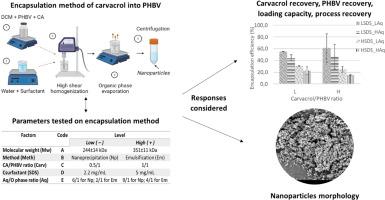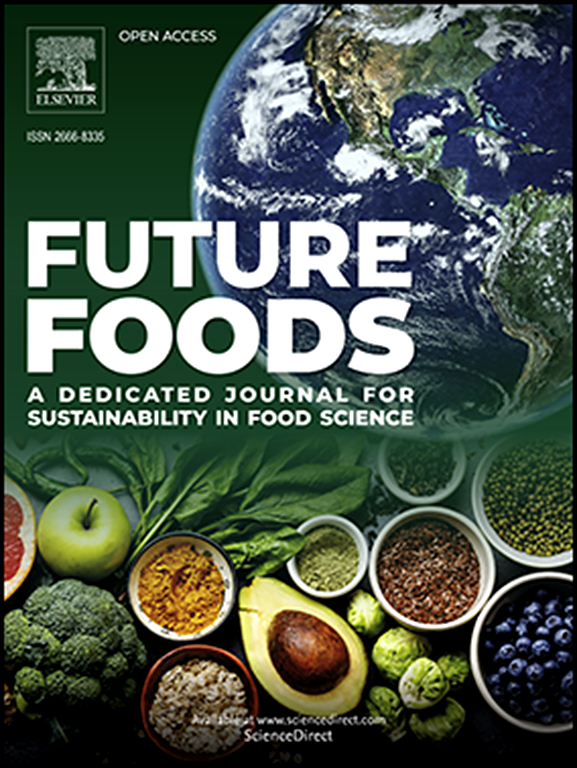Optimisation of the carvacrol encapsulation method into PHBV nanoparticles
IF 7.2
Q1 FOOD SCIENCE & TECHNOLOGY
引用次数: 0
Abstract
The need of sustainable food packaging preserving food from degradation conducted to increase research on active packaging using essential oil, as carvacrol, for their antimicrobial and antioxidant properties. The encapsulation of this kind of volatile molecules is necessary and nanoencapsulation into biopolymers, as poly(3-hydroxybutyrate-co-3-hydroxyvalerate) (PHBV) showed an increasing interest as a green solution, although this method again need to be improved. In this study, a full experimental design was developed to select the best method (nanoprecipitation and emulsification) and operating conditions (PHBV molecular weight, surfactant concentration, carvacrol/PHBV ratio and Aqueous/Organic phase volume ratios) to encapsulate carvacrol into PHBV. In this purpose, for each tested conditions, encapsulation efficiency (process efficiency, carvacrol recovery, PHBV recovery and loading capacity), as well as nanoparticles’ morphology and size were estimated, and statistically analysed. Carvacrol recovery and loading capacity were significatively highest (61 % and 100 % respectively) using emuslification method, low surfactant concentration, high carvacrol/PHBV ratio (for loading capacity) and low PHBV molecular weight (for carvacrol recovery). To the contrary, PHBV recovery increased (93 %) using the nanoprecipitation method, a high surfactant concentration and a low carvacrol/PHBV ratio, while process efficiency increased (73 %) with a low carvacrol/PHBV ratio and a low aqueous/organic phase volume ratio. Moreover, small spherical-shaped and separated nanoparticles were obtained using emulsification method, high surfactant concentration but low carvacrol/PHBV ratio. Therefore, including all the aspects of carvacrol nanoencapsulation into PHBV (shape and encapsulation efficiency) using emulsification method, with a low level for all parameters except the surfactant concentration are the most suitable strategy.

优化将香芹酚封装到 PHBV 纳米颗粒中的方法
由于需要采用可持续的食品包装来防止食品降解,因此对使用香芹酚等具有抗菌和抗氧化特性的精油进行活性包装的研究日益增多。这种挥发性分子的封装是必要的,而纳米封装到生物聚合物(如聚(3-羟基丁酸-3-羟基戊酸)(PHBV))中作为一种绿色解决方案越来越受到关注,尽管这种方法仍需改进。本研究采用完整的实验设计来选择将香芹酚封装到 PHBV 中的最佳方法(纳米沉淀法和乳化法)和操作条件(PHBV 分子量、表面活性剂浓度、香芹酚/PHBV 比率和水相/有机相体积比)。为此,对每种测试条件下的封装效率(工艺效率、香芹酚回收率、PHBV 回收率和负载能力)以及纳米颗粒的形态和尺寸进行了估算和统计分析。采用乳化法、低表面活性剂浓度、高香芹酚/PHBV 比率(负载能力)和低 PHBV 分子量(香芹酚回收率)时,香芹酚回收率和负载能力显著最高(分别为 61 % 和 100 %)。相反,采用纳米沉淀法、高浓度表面活性剂和低香芹酚/PHBV 比率时,PHBV 回收率提高了(93%);低香芹酚/PHBV 比率和低水/有机相体积比时,工艺效率提高了(73%)。此外,采用乳化法、高浓度表面活性剂和低香芹酚/PHBV 比时,可获得小球形和分离的纳米颗粒。因此,采用乳化法将香芹酚纳米包囊到 PHBV 中的所有方面(形状和包囊效率)都包括在内,并将除表面活性剂浓度以外的所有参数都控制在较低水平,是最合适的策略。
本文章由计算机程序翻译,如有差异,请以英文原文为准。
求助全文
约1分钟内获得全文
求助全文
来源期刊

Future Foods
Agricultural and Biological Sciences-Food Science
CiteScore
8.60
自引率
0.00%
发文量
97
审稿时长
15 weeks
期刊介绍:
Future Foods is a specialized journal that is dedicated to tackling the challenges posed by climate change and the need for sustainability in the realm of food production. The journal recognizes the imperative to transform current food manufacturing and consumption practices to meet the dietary needs of a burgeoning global population while simultaneously curbing environmental degradation.
The mission of Future Foods is to disseminate research that aligns with the goal of fostering the development of innovative technologies and alternative food sources to establish more sustainable food systems. The journal is committed to publishing high-quality, peer-reviewed articles that contribute to the advancement of sustainable food practices.
Abstracting and indexing:
Scopus
Directory of Open Access Journals (DOAJ)
Emerging Sources Citation Index (ESCI)
SCImago Journal Rank (SJR)
SNIP
 求助内容:
求助内容: 应助结果提醒方式:
应助结果提醒方式:


